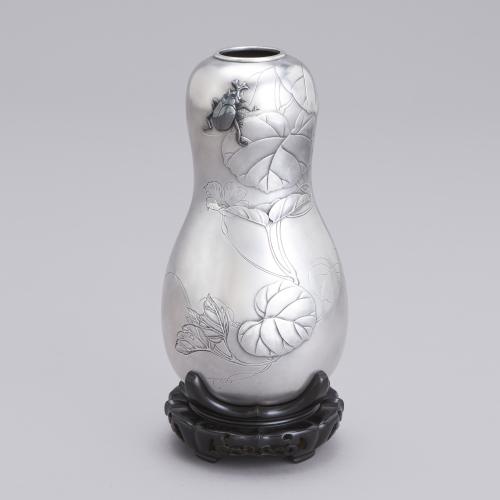
Price on application
This object is eligible for a Certificate of BADA Provenance
The BADA Standard
- Since 1918, BADA has been the leading association for the antiques and fine art trade
- Members are elected for their knowledge, integrity and quality of stock
- Our clients are protected by BADA’s code of conduct
- Our dealers’ membership is reviewed and renewed annually
- Bada.org is a non-profit site: clients deal directly with members and they pay no hidden fees
To be exhibited at
The BADA Christmas Gift ListJapanese silk Oshi-e panel depicting various insects in a procession. The three-dimensional scene worked with fine details of grasshoppers, crickets, ants and wasps carrying flowers representing a feudal lord’s journey from the Edo capital to his distant district escorted by Samurai and dignitaries. The background highlighted with gold powder and details of grasses by light brush strokes, signed 英月 Eigetsu with a square seal. Gold silk mount and with a tsuishu red lacquer frame carved with scrolling foliage, late Meiji Period.
Oshi-e 押絵 (lit. means pressed picture) also known as kiritori zaiku was a technique in which pieces were cut from an original drawing and transferred onto thick paper. These forms were covered with brocade, damask, silk or crepe pasted onto a background and then filled with paper or silk wadding to create a padded relief effect. Also very fine silver and gold threads were used to embellish the design. Only few recorded examples of this art survive today.
This technique probably dates back to the Muromachi period (1392-1573) and started in Kyoto among aristocratic ladies and later spread into Japanese society. This type of work was very time-consuming requiring lots of fine details to the dresses, faces and background within the setting. It was considered a lady's accomplishment alongside embroidery, ikebana and the tea ceremony. In the Meiji era Oshi-e and other embroidery textiles art were exported to the West.
This art genre was displayed in the 'Fancy Articles' section of the Philadelphia Centennial Exhibition of 1876. The unsettling realism of Oshie-e was immortalized in mystery writer Edogawa Ranpo's ghostly 1929 novella Oshi-e to tabisuru otoko (The man who travelled with an Oshie-e, Edogawa Ranpo zenshu (complete works of Edogawa Ranpo), 5, Tokyo, Kubunsha Bunko, 2005, pp.11-38.
Reference: "Threads of Silk and Gold, Ornamental Textiles from Meiji Japan" by H.T. McDermott and C. Pollard, The Oxford Ashmolean Museum Catalogue Exhibition, 2012, pp. 178-183.
For a similar example see the collection in the Whyte Museum in Banff Canada, Oshi-e silk panel of insects titled “Procession of Daimyo Feudal Lords’ by Sakurai Seppo, gift of Catherine Robb Whyte O.C. in 1979, catalogue number SeP.15.01.
Dimensions
H 55cm x W 96cmThe BADA Standard
- Since 1918, BADA has been the leading association for the antiques and fine art trade
- Members are elected for their knowledge, integrity and quality of stock
- Our clients are protected by BADA’s code of conduct
- Our dealers’ membership is reviewed and renewed annually
- Bada.org is a non-profit site: clients deal directly with members and they pay no hidden fees


